Jeep Wagoneer (SJ)
| Jeep Wagoneer | |
|---|---|
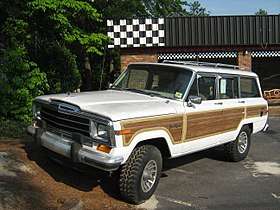 | |
| Overview | |
| Manufacturer | |
| Also called | |
| Production | 1962–June 1991 |
| Model years | 1963-1991 |
| Assembly | |
| Designer | Brooks Stevens |
| Body and chassis | |
| Class | Full-size SUV (1963–1991) |
| Body style |
|
| Layout | Front engine, rear-wheel drive / four-wheel drive |
| Platform | Full size (SJ) Jeep platform |
| Related | |
| Powertrain | |
| Engine | |
| Transmission | |
| Dimensions | |
| Wheelbase | 110 in (2,794 mm) [3] |
| Length | 186.4 in (4,735 mm) |
| Width | 74.8 in (1,900 mm) |
| Height | 66.4 in (1,687 mm) |
| Curb weight | 4,514 lb (2,048 kg) |
| Chronology | |
| Predecessor | Willys Jeep Station Wagon |
| Successor | Jeep Grand Cherokee |
The Jeep Wagoneer is the first luxury 4x4, sold and produced for Jeep by several automakers from 1962 to 1991.[4] Marketed as a station wagon, the design became known as "sport utility vehicle" (SUV) when Jeep first used the term for the 1974 Cherokee version,[5][6] the 4WD Wagoneer stayed in production for 29 model-years (1963–1991) with almost unchanged body-structure, making it the third longest-produced single generation car in U.S. automotive history.[7]
Introduced in November 1962 for the 1963 model year as a successor to the Willys Jeep Station Wagon that had been built since the end of World War II, the Wagoneer pioneered the sport utility vehicle concept. Although sharing a pickup truck chassis (like its predecessor), the Wagoneer had a sophisticated station wagon body design, that was more carlike than any other 4x4 on the market.[8] Compared with offerings from GM, Ford, International Harvester, and Land Rover — which were producing utilitarian work-oriented vehicles with spartan truck-like interiors — the Wagoneer's luxury set it apart. Together with the Gladiator Truck, the revolutionary Wagoneer SJ platform sported an advanced overhead cam straight-six engine, and offered features unheard of at the time in any other mainstream 4WD vehicle, such as independent front suspension,[9] power steering, automatic transmission,[10][11] a factory radio or air-conditioning.[2]
The Wagoneer made its debut seven years before Land Rover launched its Range Rover in Great Britain, and 24 years before that upscale marque appeared in the US. It was replaced by the smaller Jeep Grand Cherokee.
The Kaiser years
With competition from the "big three" advancing on Jeep's four-wheel-drive market, Willys management decided that a new and more advanced vehicle was needed. Conceived in the early 1960s while Willys-Overland Motors was owned by Kaiser Jeep Corporation, the Wagoneer replaced the original Willys Jeep Station Wagon, which dated from 1946 and remained in production until 1965.
Like its long-lived predecessor, the new 1963 Wagoneer took shape under industrial designer Brooks Stevens, while Willys' engineering staff handled the technical development. To appeal more to a mainstream public, the Wagoneer got a relatively low stance and car-like manners. The skirt-friendly entry height was accomplished with a married transfer-case and a thoughtful design that tucked the running gear up tight. Careful suspension tuning gave it a good ride, but because it was still a truck at heart, it could haul and tow as needed.[9] Development cost three years and around US$20 million.[12][13]
1963-1964
.jpg)
The original Wagoneer was a full-size body-on-frame vehicle which shared its architecture with the Jeep Gladiator pickup truck. At first, it offered many body types, suspension, and drivetrain options. Available as both two- or four-door wagons, the two-door could be had as a "Panel Delivery" model with windowless sides behind the doors and double "barn doors" in the rear instead of the usual tailgate and roll-down rear window.
Early Wagoneers were powered by Willys' new "Tornado" SOHC 230 cu in (3.8 L) six-cylinder engine, which had debuted in 1962 as an option for Jeep's previous Station Wagons. The engine developed 140 hp (104 kW; 142 PS) and was noted for being quite fuel-efficient for its day. There were 3-speed manual and automatic transmissions, and either was offered in 2WD rear-wheel-drive, or part-time four-wheel-drive without center differential, but with manually locking front hubs.[13] The Warn hubs were utilized to engage or disengage the front wheels, to switch the drive-train between two-wheel or four-wheel drive mode.
Like on the original Willys Wagon,[14][15] independent front suspension instead of a rigid front axle was again offered to give the Wagoneer a more car-like ride and handling.[9] The original Wagoneer featured independent front suspension (IFS) as standard on the rear-wheel drive models and was optional on the four-wheel drive,[2] for either $135 [9] or $160.[16][13]
Instead of the Wagon's "Planadyne" design, the Wagoneer's IFS used swing axles and torsion bar springs, but they combined with short upper A-arms, tied into the torsion bars at their inner pivot points, such that the swing axles served as the lower control arms in a kind of double wishbone suspension design [13][17] and the axles are located fore and aft by control links.[16] On the four-wheel-drives, the IFS replaced the standard Dana 27AF axle with a single, center-pivot front axle that allowed the Dana 27 differential to swing with the curb-side half.[18] Further, all Wagoneers had 11-inch drum-brakes all-around; seat belts were optional, and the 4WD came with a standard compass.[2][3] And for heavy-duty utility applications, front and rear power take-offs were available.[19]
Shortly after introduction of the Wagoneer, in early 1963, Willys Motors changed its name to "Kaiser Jeep Corporation".
1964 introduced factory-optional air conditioning, as well as a lower-compression 133 hp (99 kW; 135 PS) Tornado engine, because the 6-cylinder sometimes suffered cooling problems and "pinging" at altitude. While it made less power, it returned greater economy, but this lower-compression engine was phased out within a year.[13]
1965-1966
As of 1965 all models came with a new standard safety package that included front and rear seat belts, a padded dash and high impact windshield, and a dual braking system.[20]
Late-year 1965 Wagoneers and Gladiator pickup trucks were available with the 250 hp (186 kW; 253 PS) 327 cu in (5.4 L) AMC V8 engine, which proved to be a popular option. Additionally, the Tornado engine was replaced by American Motors' 232 cu in (3.8 L) OHV inline six. According to the automotive press this engine was smooth, powerful, reliable and easily maintained, but most likely it was cheaper.[9]
Although the independent front suspension was positively reviewed,[16] the option was not popular and was dropped from production, at least for the 4WD models, in 1965.[9] Some or all Wagoneers received a new front end (with eggcrate grille) for 1966.
The Super Wagoneer
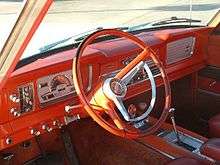
The 1966 model year also saw the introduction of the more luxurious Super Wagoneer, identified by a new more modern looking full-width grille.[13] Initially sporting a higher-performance 270 hp (201 kW; 274 PS) version of the AMC V8, fitted with a four-barrel carburetor. With comfort and convenience features not standard or even available on other vehicles of its type at the time - e.g. push-button radio, seven-position tilt steering wheel, ceiling courtesy lights, air conditioning, power tailgate, power brakes, power steering, and console-shifted TH400 automatic transmission – the Super Wagoneer is now widely regarded as the precursor of today's luxury SUVs.
Production of the Super Wagoneer ended in 1969, and in total it is believed that 3,989 Super Wagoneers were produced. [21]
1967-1971
.jpg)
Between 1967 and 1969, all rear-wheel drive only models, which the four-wheel drives had outsold from the beginning, were discontinued, and from then on all Wagoneers and Cherokees had solid axles and leaf-springs, both front and rear.[13] At the end of 1968, the slow-selling two-door versions were also discontinued.
For 1968 through 1971, Wagoneers were powered by Buick’s 350 cu in (5.7 L) 230 hp (172 kW; 233 PS) Dauntless V8. The Dauntless made less horsepower than the previous AMC V8 (230 hp vs. 250), but more torque at lower rpm (350 ft⋅lbf (475 N⋅m) at 2400 rpm versus 340 ft⋅lbf (461 N⋅m) at 2600).
After the 1971 model year, Wagoneers were exclusively AMC powered.
The AMC years
1972-1983
.jpg)
.jpg)
_Grand_Wagoneer_Limited_-_green_in_Florida.jpg)
In early 1970 AMC acquired Kaiser Jeep Corporation and began refining and upgrading the range. American Motors improved manufacturing efficiency and lowered costs by incorporating shared components such as engines. Reducing noise, vibration, and harshness improved the Wagoneer driving experience. Visually, a big change was made during the 1970 model year, by replacing the original tall, narrow grille with a new full-width design with an egg crate pattern instead of vertical bars.[13]
The 1971 model year included a special "X-coded" model finished in "golden lime" with unique wood-grain side panels, numerous convenience features and power assists, that was priced $1,000 more than the deluxe "custom" model.[22]
After 1971, the outsourced Buick 350 was replaced by the 360 cu in (5.9 L) AMC V8, and later the 401 cu in (6.6 L) was made available.
The innovative Quadra-Trac full-time four-wheel-drive system, which broadened the appeal of Jeep products to people who wanted four-wheel-drive traction without the inconvenience of a manual-shift transfer case and manual locking hubs, was introduced in 1973.
In 1974 AMC redesigned the greenhouse of the defunct two-door Wagoneer, with much wider D-pillars and single, long rear side-windows, and reintroduced it as the Cherokee. This replaced the Jeepster Commando, whose sales had not met expectations despite an extensive 1972 revamp. The Cherokee appealed to a younger market than the Wagoneer, which was regarded as a family SUV.
Also in 1974, front disc brakes were introduced as standard equipment. While the new Cherokees still had 4-wheel drum brakes standard, front discs could be had as an option.[13]
From 1976 all Wagoneer and Cherokee models received beefed up frames with stronger cross-members and boxed side rail construction.[13]
After the introduction of the Cherokee, AMC began to move the Wagoneer upmarket, and that brought high demand from a new market segment. Midway through 1978 the "Limited" was introduced, more luxuriously equipped than the earlier Super Wagoneer, offering Quadra-Trac, power disk brakes, air conditioning, power-adjustable bucket seats, power door locks, power windows, tilt steering wheel, cruise control, leather upholstery, plush carpeting, AM/FM/CB radio, leather-wrapped steering wheel, roof rack, forged aluminum wheels, and "wood grain" trim on the body sides.[12] The two-barrel, 360 cu in (5.9 L) AMC V8 engine was standard with a four-barrel, 401 cu in (6.6 L) available at extra cost. Even though the US$10,500 suggested retail price was in luxury Cadillac territory,[23] the Limited’s high-level specification attracted buyers and sales were strong with a total of 28,871 Wagoneers produced in 1978, and 27,437 in 1979.
On other SJ models there were few styling changes until 1979, when all Wagoneer and Cherokee models received a substantial styling update with one piece aluminium bumpers and a new chrome-surrounded grille with horizontal slats and square headlights.[12] This front end look would stay with the SJ body through 1991.[13]
With the V8s the primary choice among Wagoneer buyers, the 258 cu in (4.2 L) six-cylinder engine was dropped in the 1970s, only to return as an option when Jeep sales – particularly of the high-volume Cherokee – were hit by the 1979 energy crisis. (The Wagoneer continued to sell relatively well after production dropped to 10,481 in 1980, but increased to 13,741 in 1981, 18,709 in 1982, and 18,478 in 1983.) When reintroduced, the engine came with a manual transmission as standard equipment, but in 1983, automatic transmissions with “Selec-Trac” four-wheel drive became standard. With this combination, the Wagoneer achieved EPA fuel-consumption estimates of 18 mpg‑US (13 L/100 km; 22 mpg‑imp) city and 25 mpg‑US (9.4 L/100 km; 30 mpg‑imp) highway – outstanding for a full-size SUV.[24] This allowed the company to advertise good fuel mileage, although the more powerful 360 V8 remained popular with certain buyers despite its greater thirst for fuel.
In 1981, the Wagoneer line was expanded to three models. The Custom Wagoneer was the basic model, yet it included a four-speed transmission, free-wheeling hubs, power steering and power front disc brakes, as well as passenger area carpeting. A new Brougham model added an upgraded interior trim that included woodgrain for the instrument cluster and horn cover, floor mats, power tailgate window, as well as the "convenience" and "light" packages. The Brougham's exterior included a thin side body scuff moulding with a narrow woodgrain insert, roof rack, as well as bright door and quarter window frames, and a lower tailgate moulding. The Wagoneer Limited was the top-of-the-line with standard Quadra-Trac, automatic transmission, air conditioning, tinted glass, power windows and door locks, cruise control, AM/FM stereo radio, extra quiet insulation, power six-way driver and passenger bucket seats with center armrest, upgraded door panels, leather-wrapped steering wheel, extra thick carpeting, and retractable cargo cover.
The basic "Custom" model was eliminated for 1983, and a new Selec-Trac system became standard equipment. A dash-mounted control allowed the driver to change between two- and four-wheel drive. The switch activated a vacuum-activated spline clutch that was built into the front axle assembly.
1984 — The Grand Wagoneer

For 1984, AMC replaced the SJ-body Cherokee with the all-new, compact and more fuel-efficient unibody Jeep Cherokee (XJ), and introduced a upscale version of the (XJ) known as the Wagoneer. The compact XJ Wagoneer was available in two trim levels: the "Wagoneer" and the "Wagoneer Limited". AMC originally intended for these vehicles to replace the SJ-body Wagoneer models but high demand prompted the company to keep the old SJ-body Wagoneer in production alongside them despite the fact the design, largely unchanged since 1962, was becoming increasingly antiquated.
The SJ-body Wagoneer line saw consolidation in 1984 with the end of the "Brougham" model, while the "Limited" was renamed the "Grand Wagoneer" to free up the "Wagoner Limited" nameplate for compact XJ Wagoneer. In mid-1984, AMC introduced a less expensive version called the Wagoneer "Custom", without the simulated woodgrain exterior. The Custom had steel wheels with hubcaps, standard equipment was pared down, and it had part-time four-wheel drive. Despite its lower price (US$15,995, about $3,000 less than the "Grand"), sales were poor, and it was dropped after 1984.
Thus, at the end of 1984, production reached 20,019 with just one fully equipped version available. The Grand Wagoneer remained "the gold standard of the SUV market" and from 1985 it would continue in one version using the old SJ-body until the end of the Grand Wagoneer production under Chrysler.[24]

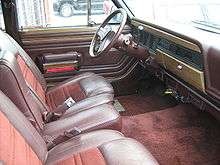
For the Mexican market, the Grand Wagoneer was built and distributed by Vehiculos Automotores Mexicanos, a subsidiary of AMC, and was offered with the 282 CI engine (which was a bored out version of the American 258 CI).
An improved handling package was introduced in 1985 that incorporated a revised front sway bar, gas filled shock absorbers, and lower friction rear springs. A total of 17,814 Grand Wagoneers were built for 1985.
Starting in the 1986 model year, the Grand Wagoneer received a new four part front grille and a stand-up hood ornament. An updated audio system became a standard feature and a power sunroof installed by American Sunroof Corporation, became a factory option. However, the most significant change was the installation of a fully revamped interior including a new dashpad, new instrumentation, new door panel design, shorter nap cut-pile carpeting, new leather seat cover designs and front seats that now featured adjustable headrests. Changes were made to the instrument panel that now featured square gauges, and contained an improved climate control system. The metal glove box door was also replaced with a plastic door featuring a woodgrain overlay. A new two spoke steering wheel also included new stalks for the lights and wiper and washer controls on the column. The Selec-Trac driveline gained a new Trac-Lok limited slip differential to send power to the wheel with the best traction. There were 17,254 Grand Wagoneers built in 1986.
The last model year developed under AMC, 1987, was also the 25th anniversary of the Wagoneer design. Standard equipment included the 360 cu in (5.9 L) V8 engine and self-sealing Michelin "Tru Seal" P235/75R 15 radial tires. The sound system included a new AM/FM electronically tuned stereo with Dolby cassette and four Jensen speakers. The exterior featured revised woodgrained sides in "marine teak" with new nameplates and V8 badges. On the inside were new tan or cordovan trims that replaced the honey and garnet colors, while the interior assist pulls on the door panels were removed. A combined 14,265 units were built by AMC and Chrysler for 1987.
Standard equipment for late Grand Wagoneers included:
- -15" Michelin all-season whitewall radial tires
- -15" alloy wheels
- -AM/FM stereo with cassette player
- -Four AccuSound by Jensen premium speakers
- -Air conditioning and heater with manual controls
- -Dual front power bucket seats
- -Leather-wrapped two spoke steering wheel
- -Leather and velour seating surfaces
- -Digital quartz dashboard clock
- -Full-size glove box
- -Roof rack with roof rails
- -Chrome front grille with hood ornament
- -Front fog driving lamps
- -Power windows and power door locks
- -Adjustable tilt steering column
- -Dual-note high-low-pitch horn
- -Power rear hatch window
- -Rear window defroster
- -Tinted windows
- -Faux wood body side vinyl wood appliques
- -Cargo cover
- -Overhead console with compass and thermometer (1989-1991)
- -keyless entry (1989-1991)
- -Rear window wiper/washer (1989-1991)
Optional equipment included:
- Towing package
- power Sunroof/moonroof
The Chrysler years
1987-1991
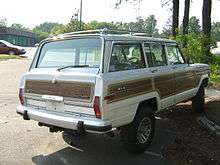
Chrysler bought out American Motors on 2 March 1987. Despite its advancing age the Grand Wagoneer remained popular. Chrysler largely left it untouched over its few years overseeing Grand Wagoneer production from the final setup under AMC's watch, and even continued to build the Grand Wagoneer with the carbureted AMC V8 instead of its own (arguably, more modern) fuel-injected V8. Year-to-year changes were minimal. At the time of Chrysler's purchase, customer demand for the Grand Wagoneers continued to be steady, and it was a very profitable model generating approximately five to six thousand dollars on each unit.[25]
The 1987–1991 model years are considered the "best of the breed" due to a number of upgrades. These include upgraded wood siding and modernized aluminum wheels that lost their gold colored inlays in favor of gunmetal grey metallic. All exterior colors were now applied in a two-stage base-clearcoat system.
Many improvements were made for the 1989–1991 model year series, including a quality replacement for the earlier, leak-prone air conditioning compressor, the addition of the visually identifiable rear wiper assembly, as well as a general improvement in fit and finish. An interior overhead console, taken from Chrysler's popular minivans, was also added. This functional console featured much brighter map lights, an outside temperature sensor and compass, and an infrared remote-controlled key-less entry system.
The last model years also featured new paint colors. These "new" colors included the rare hunter green metallic that was only available in the 1991 model year and is the paint color of the 1991 Grand Wagoneer in the Chrysler museum, as well as the color of the very last Grand Wagoneer ever made, which was a significant part of the historic collection at the National Automobile Museum.
Discontinuation
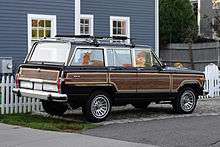
The Wagoneer enjoyed one of the longest production runs of any Jeep product.[26] The powerful V8 engine and high towing capacity made the Grand Wagoneer popular among its many repeat buyers, and by 1991, it was the longest domestically produced vehicle (29 years) on the same platform.[7] The 1987–1991 models years are considered "the best of the breed and still have a loyal following among a select group".[27] Late model, low mileage, rust free Grand Wagoneers have become highly collectable with some vehicles selling for more than their original sticker price nearly three decades after they rolled off the assembly line.
A total of around 4,200 SJ Grand Wagoneers were produced in the 1991 model year. Owners had the option of having a "Final Edition Jeep Grand Wagoneer" badge on the dashboard.[27]
The last Grand Wagoneer produced rolled out of Chrysler's Toledo Assembly Plant on 21 June 1991.[28][29][30]
1993
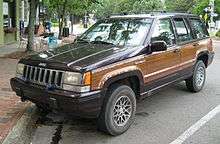
In 1993, the Jeep Grand Wagoneer made a brief one year reappearance as the top of the line model of the Jeep ZJ platform. It featured a long list of standard equipment including a 5.2 L V8 engine and unique leather interior as well as the Grand Wagoneer’s traditional exterior woodgrain applique.
Competition
The Wagoneer was occasionally used in rallying, mainly in the United States. Wagoneers placed first and second in the first-ever running of the Sno*Drift rally in 1973.[31]
A Grand Wagoneer also competed in the 9,000-mile 1988 Trans-Amazon Rally.[32]
Revival
Chrysler Group CEO Sergio Marchionne announced at the January 2011 North American International Auto Show held in Detroit, that the Grand Wagoneer name was to be revived for an "upper-scale" seven-seat SUV, which he said would be introduced in 2013.[33] In February 2013, the Jeep product planning team took a research trip to Wagonmaster, a company dedicated to restoring and reselling classic Grand Wagoneers.[34] On 2 September 2013, Chrysler announced that they would delay production until 2015 to allow the Dodge Durango to find an audience, but at the same time would use the Grand Wagoneer concept as a basis for a full-size luxury SUV that would compete against the Cadillac Escalade and Lincoln Navigator, whose redesigns went on sale in 2014.[35]
In May 2014, Chrysler Corporation's "Five-Year Plan" was unveiled, and the plan noted that Chrysler Corporation was planning to release a flagship vehicle called the Grand Wagoneer that would share a platform with the Dodge Durango and Jeep Grand Cherokee by the 2018 model year. Originally planned to replace the Dodge Durango, the Grand Wagoneer will be sold alongside that vehicle, as well as the Jeep Grand Cherokee. The new vehicle was to be built at Chrysler Corporation's Jefferson North Assembly Plant (JNAP), where the Dodge Durango and Jeep Grand Cherokee are being produced. The new vehicle would replace and fill the vacant spot of the Jeep Commander, which ceased production in 2010 due to low demand.
On 9 June 2015, Fiat Chrysler announced that it will unveil a new version of the full sized Grand Wagoneer at its dealers convention on 25 August 2015.[36] In August 2015, however, Fiat announced that the production of the upcoming Grand Cherokee replacement will be delayed into 2018.[37] It is scheduled to be built at Warren Truck Assembly when the next generation Ram 1500 is to be built at Sterling Heights Assembly.[38] On 18 October 2016, Jeep released teaser photos of the Grand Wagoneer, which indicates that it will be based on the Durango as evidenced by the design and details, and is targeted to be introduced as a 2019 model.[39]
See also
References
- ↑ "Pars Khodro in history" (PDF). Archived from the original (PDF) on 12 March 2012. Retrieved 23 July 2014.
- 1 2 3 4 "1962 Jeep Wagoneer brochure". Oldcarbrochures.com. Retrieved 23 July 2014.
- 1 2 "1962 Jeep Wagoneer brochure – specifications". Oldcarbrochures.com. Retrieved 23 July 2014.
- ↑ Truesdell, Richard (31 August 2004). "Move Over, Range Rover" (PDF). Retrieved 23 July 2014.
- ↑ Allen, Jim (2003). Jeep: Collector's Library. Motorbooks, MBI Publishing. p. 168. ISBN 978-0-7603-1486-9. Retrieved 13 February 2018.
- ↑ "1974 Jeep Cherokee brochure page". Troxel's autopaper.com. Retrieved 13 February 2018.
- 1 2 "Grand Wagoneer". Road & Track. 43: 214. 1992.
- ↑ Lewin, Tony; Borroff, Ryan (2003). How to Design Cars Like a Pro: A Comprehensive Guide to Car Design from the Top Professionals. MotorBooks/MBI Publishing. p. 191. ISBN 978-0-7603-1641-2. Retrieved 23 July 2014.
- 1 2 3 4 5 6 Allen, Jim (9 January 2015). "1963 Jeep Wagoneer Custom - Backward Glances". Four Wheeler. Retrieved 15 May 2015.
- ↑ "The Icon: Jeep Wagoneer". Allpar. Retrieved 15 May 2015.
- ↑ Foster, Patrick (1 January 2008). "1963 Jeep Wagoneer - Landmark Vehicle". Four Wheeler. Retrieved 15 May 2015.
- 1 2 3 "History of the Wagoneer (source: Just 4x4s Magazine)". Archived from the original on 27 January 2010. Retrieved 23 July 2014.
- 1 2 3 4 5 6 7 8 9 10 11 Sean. "A look back at the 1963 - 1991 Jeep Wagoneer: A guide to year-to-year changes". classiccarstodayonline.com. Retrieved 13 February 2018.
- ↑ Donnelly, Jim (August 2009). "Willys' Wagon - 1962 Ruggedly designed, the 1962 Willys wagon was an exercise in simplicity". Hemmings Classic Car. Retrieved 13 February 2018.
- ↑ Brown, Arch (1994). "Chapter Four – Postwar Plans for Willys: 1945-52". Jeep: The Unstoppable Legend. Publications International. p. 70. ISBN 0-7853-0870-9. LCCN 94-66811.
- 1 2 3 Wright, Jim (March 1963). "First Test: Willys Jeep Wagoneer - The Jeep Becomes A Gentleman: New Turnpike Engine and Country Club Look -- Same Old Backroad Dependability". Motor Trend. Retrieved 15 May 2015.
- ↑ "1962 Jeep Wagoneer brochure". oldcarbrochures.com. p. 5. Retrieved 13 February 2018.
- ↑ "Detail of the independent front suspension axle on a Jeep Wagoneer 4x4". apicalnetworks.com. Archived from the original on 10 August 2014. Retrieved 15 May 2015.
- ↑ "1962 Jeep Wagoneer brochure". oldcarbrochures.com. p. 7. Retrieved 13 February 2018.
- ↑ "1965 Jeep full-line brochure". oldcarbrochures.com. p. 3. Retrieved 13 February 2018.
- ↑ Truesdell, Richard (31 August 2004). "Move Over, Range Rover" (PDF). Retrieved 16 September 2017.
- ↑ Allen, Jim (2004). Jeep: Collector's Library. MBI Publishing. p. 155. ISBN 978-0-7603-1979-6.
- ↑ Flory, Jr., J. Kelly (2012). American Cars, 1973–1980: Every Model, Year by Year. McFarland. ISBN 9780786443529.
- 1 2 Auto Editors of Consumer Guide (29 August 2007). "1980-1989 Jeep Wagoneer". auto.howstuffworks.com. Retrieved 23 July 2014.
- ↑ Dunne, Jim (October 1987). "What will Chrysler Do With All Those Chips?". Popular Mechanics. 164 (10): 54. Retrieved 23 July 2014.
- ↑ Statham, Steve (2001). Jeep. MotorBooks International. p. 76. ISBN 978-0-7603-1006-9. Retrieved 23 July 2014.
- 1 2 Allen, Jim (2004). Jeep. MotorBooks International. p. 166. ISBN 978-0-7603-1979-6. Retrieved 23 July 2014.
- ↑ "Museum gets last Grand Wagoneer". Toledo Blade. 24 July 1991. p. 32.
- ↑ Christenson, Wayne (December 1991). "The Last Wagoneer". Four Wheeler: 62–66.
- ↑ Ford, Vikki (November 1991). "The Last Grand Wagoneer Marks the End of an Era". Journal of the National Automotive Museum: 1–2.
- ↑ "Sno*Drift Results Through the Years: 1973–1978". sno-drift.org. Archived from the original on 24 September 2015. Retrieved 23 July 2014.
- ↑ Jensen, Cheryl; Jensen, Christopher (27 November 1988). "The Road Through Hell...is Paved With Auto Parts And Human Sanity As Two Midwesterners Learned In The Transamazon Marathon Rally". Chicago Tribune. Retrieved 23 July 2014.
- ↑ Wernle, Bradford (10 January 2011). "Jeep to dust off Grand Wagoneer name for 7-seat SUV". Automotive News. Retrieved 23 July 2014.
- ↑ Bowman, Zach (1 February 2013). "Jeep team takes a field trip to Wagonmaster; researching next Grand Wagoneer?". Autoblog. Retrieved 23 July 2014.
- ↑ Vellequette, Larry P. (2 September 2013). "Jeep plans baby Wrangler, big SUV". Automotive News. Retrieved 23 July 2014.
- ↑ "Jeep will show new Grand Wagoneer to dealers this summer" from Autoblog (8 June 2015)
- ↑ Berr, Jonathan (3 September 2015). "Will Chrysler's revived Wagoneer be a new Woody?". CBS. Retrieved 3 July 2017.
- ↑ "FCA to move Ram to Sterling Heights, Jeep to Mexico".
- ↑ "2019 Jeep Grand Wagoneer Spied: Its Grand Alright" from Car and Driver (20 October 2016)
External links
| Wikimedia Commons has media related to Jeep Wagoneer. |
| Wikimedia Commons has media related to Jeep Grand Wagoneer. |
- International Full Size Jeep Association
- Vintage Jeeps
- Wagoneer World - Year by year info & specs 1963-1991
- wagoneers.com
- Jeep Wagoneer at the Internet Movie Cars Database
Jeep road vehicle timeline, 1945–1970s — next » | |||||||||||||||||||||||||||||||||||
|---|---|---|---|---|---|---|---|---|---|---|---|---|---|---|---|---|---|---|---|---|---|---|---|---|---|---|---|---|---|---|---|---|---|---|---|
| Type | 1940s | 1950s | 1960s | 1970s | |||||||||||||||||||||||||||||||
| 5 | 6 | 7 | 8 | 9 | 0 | 1 | 2 | 3 | 4 | 5 | 6 | 7 | 8 | 9 | 0 | 1 | 2 | 3 | 4 | 5 | 6 | 7 | 8 | 9 | 0 | 1 | 2 | 3 | 4 | 5 | 6 | 7 | 8 | 9 | |
| Traditional | CJ-2A | CJ-3A | CJ-5 | ||||||||||||||||||||||||||||||||
| CJ-3B | CJ-7 | ||||||||||||||||||||||||||||||||||
| CJ-6 | |||||||||||||||||||||||||||||||||||
| Dispatcher | DJ-3A | DJ-5/6 | AM General | ||||||||||||||||||||||||||||||||
| Compact SUV | Jeepster (VJ) | Jeepster Commando | Commando | ||||||||||||||||||||||||||||||||
| SUV | Willys Jeep Station Wagon | Cherokee (SJ) | |||||||||||||||||||||||||||||||||
| Wagoneer (SJ) | |||||||||||||||||||||||||||||||||||
| Compact pickup | Jeepster Commando | Commando | |||||||||||||||||||||||||||||||||
| Full-size pickup | Willys Jeep Truck | ||||||||||||||||||||||||||||||||||
| Gladiator | J-Series | ||||||||||||||||||||||||||||||||||
| Truck | Forward Control | ||||||||||||||||||||||||||||||||||
| Van | FJ-3/3A | FJ-6/6A | |||||||||||||||||||||||||||||||||
« previous — Jeep road vehicle timeline, 1980s–present | ||||||||||||||||||||||||||||||||||||||||
|---|---|---|---|---|---|---|---|---|---|---|---|---|---|---|---|---|---|---|---|---|---|---|---|---|---|---|---|---|---|---|---|---|---|---|---|---|---|---|---|---|
| Type | 1980s | 1990s | 2000s | 2010s | ||||||||||||||||||||||||||||||||||||
| 0 | 1 | 2 | 3 | 4 | 5 | 6 | 7 | 8 | 9 | 0 | 1 | 2 | 3 | 4 | 5 | 6 | 7 | 8 | 9 | 0 | 1 | 2 | 3 | 4 | 5 | 6 | 7 | 8 | 9 | 0 | 1 | 2 | 3 | 4 | 5 | 6 | 7 | 8 | 9 | |
| Traditional | CJ-5 | |||||||||||||||||||||||||||||||||||||||
| CJ-7 | Wrangler (YJ) | Wrangler (TJ) | Wrangler (JK) | Wrangler (JL) | ||||||||||||||||||||||||||||||||||||
| Wrangler Unlimited (LJ) | Wrangler Unlimited (JKU) | Wrangler Unlimited (JLU) | ||||||||||||||||||||||||||||||||||||||
| Subcompact crossover | Renegade (BU) | |||||||||||||||||||||||||||||||||||||||
| Compact crossover | Compass (MK49) | Compass (MP) | ||||||||||||||||||||||||||||||||||||||
| Patriot (MK74) | ||||||||||||||||||||||||||||||||||||||||
| Cherokee (KL) | ||||||||||||||||||||||||||||||||||||||||
| Mid-size crossover | Grand Commander | |||||||||||||||||||||||||||||||||||||||
| Compact SUV | Cherokee/Wagoneer (XJ) | Liberty/Cherokee (KJ) | Liberty/Cherokee (KK) | |||||||||||||||||||||||||||||||||||||
| Mid-size SUV | Grand Cherokee/Grand Wagoneer (ZJ) | Grand Cherokee (WJ) | Grand Cherokee (WK) | Grand Cherokee (WK2) | ||||||||||||||||||||||||||||||||||||
| Commander (XK) | ||||||||||||||||||||||||||||||||||||||||
| Full-size SUV | Cherokee (SJ) | |||||||||||||||||||||||||||||||||||||||
| Wagoneer/Grand Wagoneer (SJ) | ||||||||||||||||||||||||||||||||||||||||
| Compact pickup | CJ-8 (Scrambler) | Comanche (MJ) | ||||||||||||||||||||||||||||||||||||||
| Midsize pickup | CJ-10 | |||||||||||||||||||||||||||||||||||||||
| Full-size pickup | J-Series | |||||||||||||||||||||||||||||||||||||||